6 Gen Zers Talk Navigating A Multi-Racial Identity and Why Race Still Matters

Jenna Brillhart, HelloGiggles
From the ways they spend their time to the ways they communicate (hello, TikTok!), members of Gen Z lead very different lives than the rest of us. But as HelloGiggles' Generation Next explores, there's a lot we can learn from them—whether it's their need for mental health support, their drive for self-expression, or their commitment to making the world a more inclusive place for all.
Gen Z, the generation born between 1997 and 2012, is the most racially and ethnically diverse generation yet with more than half of American members identifying with two or more races. By 2026, this generation is projected to become a minority-majority population, or majority nonwhite––representing even more of the multiplicity of identities that make up America.
As the country becomes increasingly diverse, a common misconception is that "race just won't matter anymore." But as last summer's Black Lives Matter demonstrations showed us, race continues to exhibit importance in our collective society, especially in 2021. And no one is more aware of how race affects every fiber of one's lived experience than those who identify as multi-racial, especially for young people who are still figuring out and navigating their own identities.
Multi-racial, or mixed race, persons often face immense challenges having to navigate more than one racial identity, from struggling to fit into social circles to feeling like they have to box themselves into one identity or category. Multi-racial people are also, more often than not, forced to have these difficult conversations around race with others, especially when one part of their identity is perceived as racially superior to the other. Many even feel pressured by loved ones and/or society to identify with one race rather than both. And with 22% of Gen Zers being children of immigrants, compared to 14% of Millennials, that age group is dealing with these issues more than ever before.
To better understand some of the challenges around race that this generation has had to navigate, HelloGiggles spoke to six Gen Zers from various racial and ethnic backgrounds about their personal experiences and why race should still matter today. Here's what they said.
Danielle, 24, she/her, African-American and white

HelloGiggles, Emily Lundin
"I grew up with my father, who is Caucasian, and there was a barrier [between us]. Being at school and not considered 'white passing' was tough as I felt the need to constantly straighten my hair and do whatever I needed to fit in. I felt lost as a person and desired to be fully white so badly.
"I never felt like I belonged. I was 'too Black' for the white kids and 'too white' for the Black kids. Although I have many white and Black friends, it took me a long time to feel accepted.
"I discovered the other half of my identity by attending a predominantly Black college, where I felt whole for the first time. I wouldn't want to change anything about myself today. I love being mixed and it offers me a different perspective than others.
"However, my father is a conservative, white retired cop. The issues I had experienced as a child and teen were not addressed and I was extremely uneducated about the Black community. When the current Black Lives Matter movement began, it forced me to create boundaries. Although I've tried to educate my father on human rights and the true meaning behind our movement, our conversations do not seem to have been successful. However, I will continue to embrace both sides of my identity and not suppress one because of someone else's ignorance.
"I only feel pressured to identify with one race when I have to fill out an application. Sometimes you're not allowed to choose more than one answer. I hate feeling like I have to choose. I am both Black and white, therefore I will always identify as both."
Marisa, 22, she/her, Black, Filipino, Lebanese, and Puerto Rican
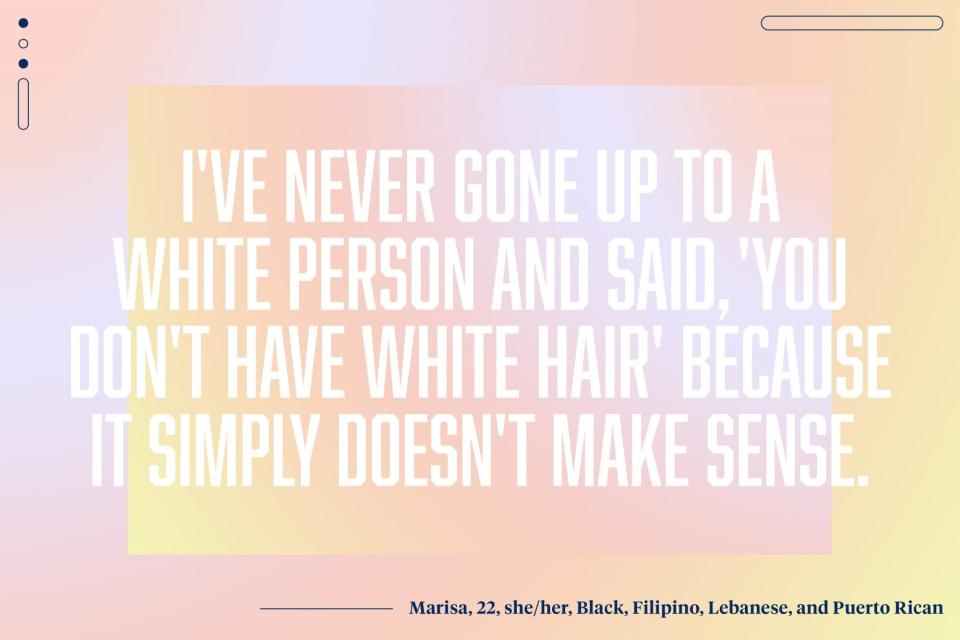
HelloGiggles, Emily Lundin
"Growing up in a predominantly white community, being [multi-racial] was very hard. Although I was young, I knew racism was already instilled into kids' minds. I found myself bouncing between cliques to see who would accept me, but I remained confused about where I stood with friends or with my friends' parents' perceptions of me. I would get made fun of for my hairy arms, bushy eyebrows, and interracial parents; kids used to assume I was adopted.
"When I got to high school, the large amount of racism and misogynoir I faced radicalized me. I learned to stick up for myself, other Black and Brown people, and anyone who was oppressed. I was known as the 'angry Black girl,' but I didn't care because I knew I was doing the right thing—even if adults thought otherwise.
"As a writer, I am now able to document and embrace other people's identities as well as my own. I am also able to acknowledge issues in marginalized communities without being called the 'angry Black girl.' But even now, many people still ask, 'what are you?' 'You don't have Black hair,' is also a common remark I receive, and I do not care to respond, as 'Black hair' is subjective, stereotypical, and a term that is irrelevant in the Black community since there are many different textures, types, and curl patterns in 'Black hair.' I've never gone up to a white person and said, 'You don't have white hair,' because it simply doesn't make sense.
"For as long as I can remember, I have tried very hard to feel comfortable with my identity. I've thought about whether to identify as multi-racial or just Black. I see both. I see a woman with Black skin, yet exhibiting other multi-racial features as well. Every day, I am learning to love and fully embrace myself. From my body and body hair to my acne scars, skin, lack of curves, unique features, everything."
Mira, 19, she/her, South Asian, Mexican, Puerto Rican, and European
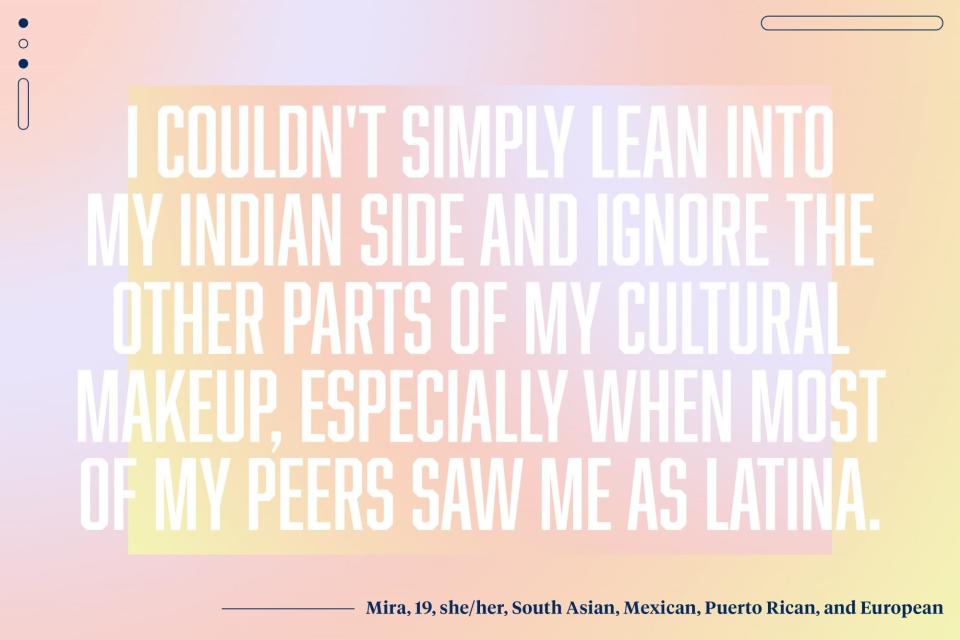
HelloGiggles, Emily Lundin
"I grew up in a majority-minority community in central Georgia, where I attended a diverse public school––my classmates were about 60% Asian, and less than 20% Black or Brown. I check off a lot of boxes: I am South Asian, Mexican, Puerto Rican, and European––I only make the distinction from Caucasian because my grandmother is an Austrian immigrant who fled Europe during World War II.
"Growing up, I mostly ignored my multi-racial identity and participated in the social groups that I fell into naturally. My parents always encouraged me to do well in school, so I befriended the high-achieving Asian students. Because of this, and the high concentration of Asian Americans in my area, I came to identify mostly with my South Asian side. I attended Hindu religious functions, read Hindu mythology, ate Indian food, and learned a few words in Hindi and Telugu.
"Still, I couldn't simply lean into my Indian side and ignore the other parts of my cultural makeup. As someone who looks obviously Latina, I endured an onslaught of racism from peers. Freshman year, a girl found out that I was Indian and remarked, 'Oh, so that's why you're smart!' as if an intelligent Hispanic student was unfathomable or required an explanation. Other students also commented on my appearance, their microaggressions stinging my pride. Senior year, a friend turned to me in class and said, 'You look more Hispanic today.' While I was confused at first, I realized it was because I was wearing hoop earrings.
"When this switch flipped, I made an effort to learn about my diverse background. I berated my grandparents with questions about where our family came from, pored over documents, and created an Ancestry.com account. I only began to feel comfortable in my identity when I became friends with a few other multi-racial girls in high school because I related to their experiences of having one foot in each world. They were the first people I confided in about feeling out of place in my own skin.
"Now, entering my sophomore year of college, I am trying to lean into the areas of my identity that were absent in my youth, as I never connected with the Hispanic community growing up. I can only hope to grow closer to that side of me. I am still learning how to fully embrace my existence as an awkward individual in between communities, but my multi-racial peers have made the journey so much easier."
Anonymous, 23, she/her, Black and Filipino
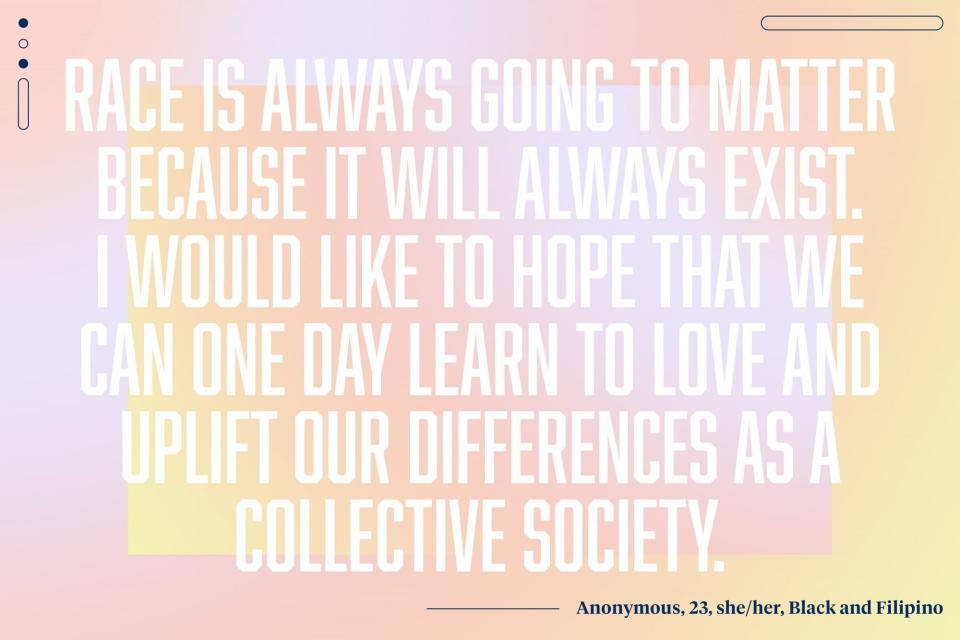
HelloGiggles, Anonymous
"When I was younger, I always tried to be accepted into both communities by trying to fit in, but I was never 'Black enough' nor 'Asian enough.' It was frustrating.
"When my parents divorced, I lived with my mom, who is Asian. So, most of my cultural identity is associated with my Filipino side. I spent most of the time with her and her family. My mom never talked to me about my race.
"When I was around 17, I realized that it wasn't really my family that I had to worry about treating me differently, it was everyone around me. I always felt like an outsider with Asian people and Black people. For a long time, I was only comfortable with white friends because when I am around other POCs I feel like a phony. Since I have the privilege of having lighter skin and ambiguous features often fetishized in American culture, I feel like I can't relate to a lot of the struggles either side has experienced. I am slowly getting more comfortable with my identity by understanding that there is so much more depth to people, and there is no singular Asian or Black experience, and so there is nothing for me to worry about proving.
"Now that I am older, I identify with being multi-racial or mixed race. I understand that I will never completely fit into one box, but being mixed is a race and an experience in and of itself; it's valid. Instead of describing myself as two halves, Black and Asian, I describe myself as a whole, multi-racial person."
Rewan, 21, they/she, Bi-racial Egyptian
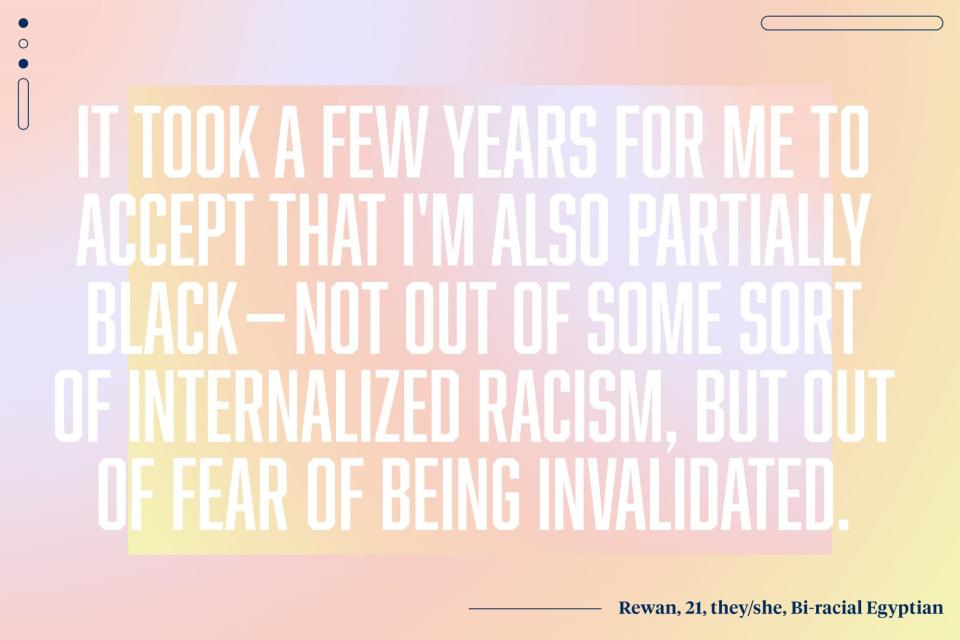
HelloGiggles, Emily Lundin
"As a kid, I didn't really realize I was multi-racial. Both of my parents are Egyptian so I thought that was that. It wasn't until high school when I looked at my two sisters and realized we were all dramatically different hues despite having the same set of parents. I came to the realization that my dad isn't only Egyptian, but also Black.
"It took a few years for me to accept that I'm also partially Black––not out of some sort of internalized racism, but out of fear of being invalidated. I didn't want to be told that I'm not 'Black enough,' especially not being African-American and not relating to Black American culture, so I ignored it. Today I recognize my privilege in being ethnically ambiguous. While honoring my Black heritage, I always take the time to listen to and uplift the voices of my darker-skinned brothers and sisters because I'm aware that many people don't look at me and associate me with Blackness.
"I am definitely still learning to love my multi-racial existence. I still invalidate myself a lot and sometimes don't know how to identify, which is really frustrating. My family doesn't like to discuss the family's race and only identify as Egyptian. I still have so many questions about my lineage that will go unanswered because I am only familiar with my immediate family, and hopefully one day I will learn to accept that ambiguity."
Melanie, 19, she/her, Mexican and Native American
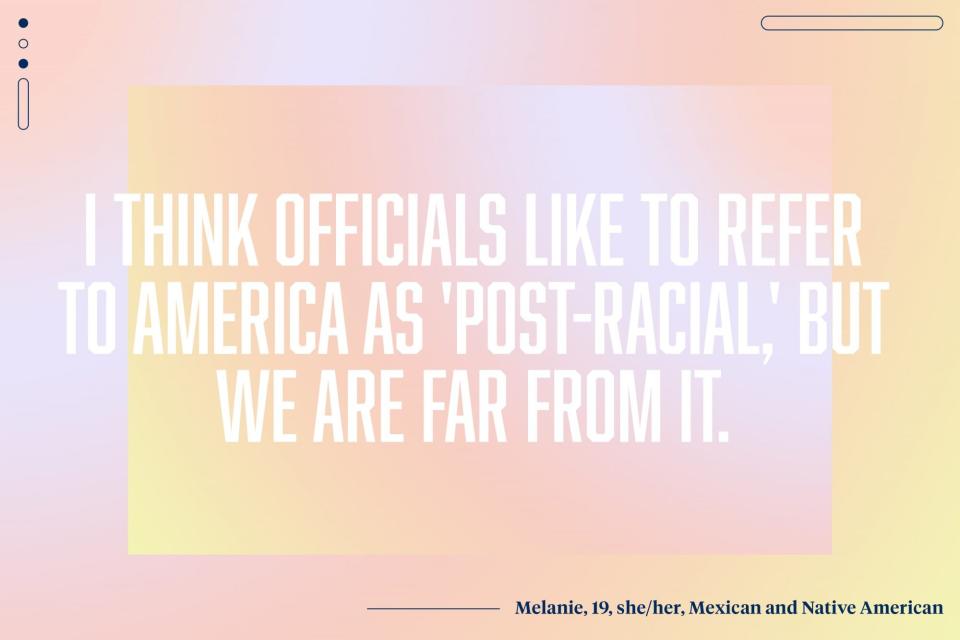
HelloGiggles, Emily Lundin
"My parents are divorced, so I grew up in a divided household in a middle-class suburb of Southern California. It wasn't until my junior year of high school that I realized the impact of my multi-racial identity, when I took a college course on Ethnic Studies. I started to explore my Native American side, something that was brushed under the rug and even teased by my own family members who said we were a part of the "yucky" tribe. (We are Pascua Yaqui (Yaw-kee).) My other half is Mexican, but my parents didn't teach my siblings and I Spanish. Besides taking a couple of years of Spanish in high school, I never became fluent in the language. Some people would refer to us as 'white-washed,' which has always been hurtful.
"I think now I am navigating my identity as a continual learning experience. As a second-year college student, I've learned more about how cultural identities are important, and I'm continuing to learn more about my tribe and our native language. I'm also studying Spanish and learning where my grandparents come from.
"Still, as a multi-racial person who is white-passing, it's hurtful to have to explain to people I meet that I am both Native and Mexican, even if I don't 'look like it.' I have definitely felt misunderstood in my racial identities, and still do sometimes. A couple of months ago I had a late-night breakdown about how I identify. I felt like an imposter in claiming that I am Native and Mexican. I think many people are really confident in their racial identities, as they might have grown up very attached to their roots, whereas I didn't realize the importance of my roots until I was older.
"[Elected] officials like to refer to America as 'post-racial,' but we are far from it. Even though race is a social construct, hegemonic systems and institutions still uphold racial stereotypes and racial profiling. So, race still matters today because we, as a society, should constantly be learning about different racial viewpoints, their intersections with gender, sex, class, etc. I know you can't please everyone, but for years, people have been marginalized and their voices stomped on—and we can't ignore that."

